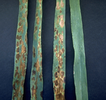International Database for Barley Genes and Barley Genetic Stocks
BGS 611, Necrotic leaf spot 6, Nec6
Stock number: BGS 611
Locus name: Necrotic leaf spot 6
Locus symbol: Nec6
Previous nomenclature and gene symbolization:
Spotted = Sp (3).
Inheritance:
Monofactorial dominant (3).
Located in chromosome 7HS (1); Nec6.h is associated with SNP markers 1-0949 to 1-1031 (positions 0.00 to 7.83 cM) in 7H bin 01 of the Bowman backcrossed-derived line BW633 (1), in 7H bin 01.
Located in chromosome 7HS (1); Nec6.h is associated with SNP markers 1-0949 to 1-1031 (positions 0.00 to 7.83 cM) in 7H bin 01 of the Bowman backcrossed-derived line BW633 (1), in 7H bin 01.
Description:
Numerous dark-brown, oval to elongated spots form on all foliar parts of plants homozygous or heterozygous for the Nec6 gene. The spots are pinpoint in size when they first appear and gradually enlarge to a diameter of 10 to 15 mm. The spots appear on the first leaf when seedlings are at a three to four-leaf stage and on succeeding leaf when the leaf blade has partially expanded. The spots may cover 20 to 30% of the leaf blade area, but areas adjacent to the spots remain green. Average grain yield reduction in spotted isogenic lines was 13.6% (3). Plant height and kernel plumpness are slightly reduced in the Bowman backcross-derived line BW633 (2).









Origin of mutant:
A spontaneous mutant in Awnless Atlas (CIho 10965) (3).
Mutational events:
Nec6.h (GSHO 977) in Awnless Atlas (CIho 10965) (3).
Mutant used for description and seed stocks:
Nec6.h in Spotted Quarter-awned Atlas (GSHO 2424); Nec6.h in Bowman (PI 483237)*7 (GSHO 3429, BW633, NGB 22199).
References:
1. Druka, A., J. Franckowiak, U. Lundqvist, N. Bonar, J. Alexander, K. Houston, S. Radovic, F. Shahinnia, V. Vendramin, M. Morgante, N. Stein, and R. Waugh. 2011. Genetic dissection of barley morphology and development. Plant Physiol. 155:617-627.
2. Franckowiak, J.D. (Unpublished).
3. Schaller, C.W., and C.O. Qualset. 1975. Isogenic analysis of productivity in barley: Interaction of genes affecting awn length and leaf-spotting. Crop. Sci. 15:378-382.
2. Franckowiak, J.D. (Unpublished).
3. Schaller, C.W., and C.O. Qualset. 1975. Isogenic analysis of productivity in barley: Interaction of genes affecting awn length and leaf-spotting. Crop. Sci. 15:378-382.
Prepared:
J.D. Franckowiak. 2002. Barley Genet. Newsl. 32:112.
Revised:
J.D. Franckowiak. 2013. Barley Genet. Newsl. 43:159.
